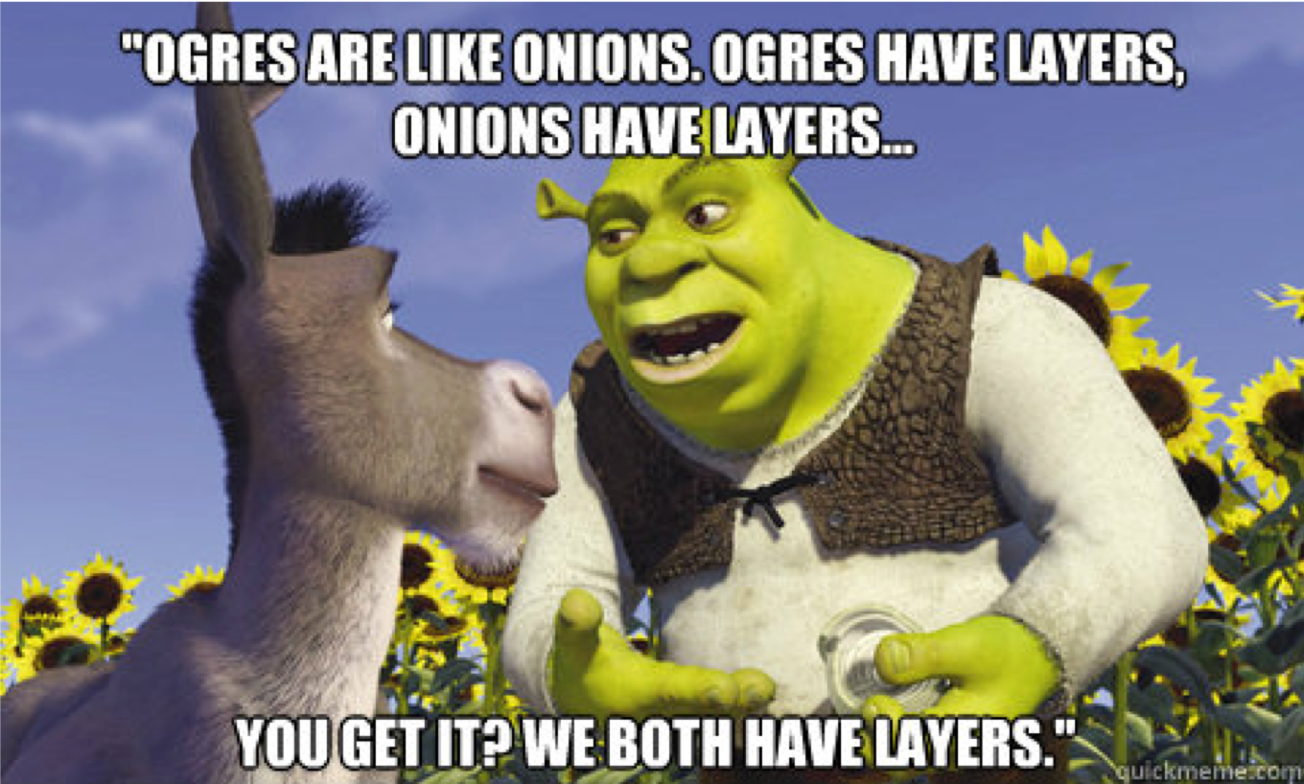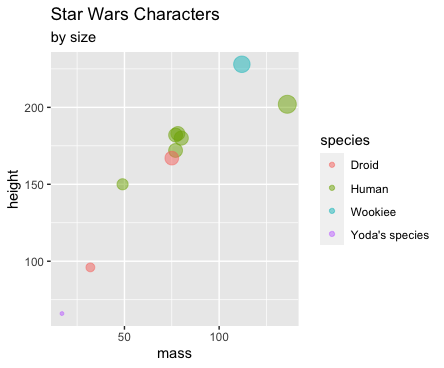Basic Statistics & Plotting
You've already learned a lot!
Hopefully you're feeling more comfortable with some of terminology used in programming:
- Objects
- Classes
- Functions
- Arguments
- Vectors
- Data.frames
- Etc.
Uhh...no?
You already know everything you need to do stats & plots!
Uhh...no?
You already know everything you need to do stats & plots!
Statistics
All statistics are computed with functions.
If you know the type of analysis you want to run, find the corresponding function and go for it!
Uhh...no?
You already know everything you need to do stats & plots!
Statistics
All statistics are computed with functions.
If you know the type of analysis you want to run, find the corresponding function and go for it!
Plotting
All plots are made with functions.
Slightly different is that one particular package is a lot better at plotting than base R.
Today
Very basic statistics
Introduction to plotting with
ggplot2- There will be MUCH more on data visualization later
PRACTICE PRACTICE PRACTICE
About the MIDUS dataset
Variables available in this data file:
- Demographic variables: age, sex
- Physical health variables: self-rated physical health, heart problems, father had heart attack, BMI
- Mental health variables: self-rated meantal health, self-esteem, life satisfaction (life overall, work, health, relationship with spouse/partner, relationship with children), hostility (stress reactivity & agression)
About the MIDUS dataset
Variables available in this data file:
- Demographic variables: age, sex
- Physical health variables: self-rated physical health, heart problems, father had heart attack, BMI
- Mental health variables: self-rated meantal health, self-esteem, life satisfaction (life overall, work, health, relationship with spouse/partner, relationship with children), hostility (stress reactivity & agression)
Please load in midus, make sure:
- Make sure the variables
sex,heart_self, andheart_fatherarefactor()variables (rather than characters) - Use the same
na.omit()function to remove allNAvalues
Before we begin...
Check to make sure you have the
ggplot2package installedCheck to make sure the
ggplot2package is loadedIf "no" to either, how can you solve this?
Data visualization with ggplot2

Plotting with ggplot2
ggplot2 has the following structure:
ggplot(things that impact the entire plot) + geom_something(things that impact just the something)Plotting with ggplot2
ggplot2 has the following structure:
ggplot(things that impact the entire plot) + geom_something(things that impact just the something)Things like:
- data.frame used for plotting
- defining your x & y axes
Plotting with ggplot2
ggplot2 has the following structure:
ggplot(things that impact the entire plot) + geom_something(things that impact just the something)geom_ typically means shape. What shapes do you want to use to represent your data in the plot?
geom_histogram-- histogramgeom_density-- distributionsgeom_violin-- distributionsgeom_point-- scatter plotgeom_col-- bar plot
Plotting with ggplot2
The functions ggplot() and geom_() can take on different aesthetics as an argument, using aes().
Aesthetics are how you control what you want your plot to look like; how can you make it pretty? Examples:
- Which variables are the
x-andy-axes? color(should you color the plot by some variable?)fill(very similar tocolor, should you fill the plot in somehow; used for bar graphs and boxplots)shape(do you want groups to have different shaped points?)size(how big should plotted data be?)
Note: person that made this package is from New Zealand; the British spellings and American spellings work! Although using tab-complete my auto-fill the British spellings
Plotting with ggplot2
- Usually
aes()contains some information that comes directly from the data - If the information is not based on the data, it does not need to be inside an
aes()argument.
ggplot(data = midus, aes(x = age, y = BMI)) + geom_point()
Plotting with ggplot2
- Usually
aes()contains some information that comes directly from the data - If the information is not based on the data, it does not need to be inside an
aes()argument.
ggplot(data = midus, aes(x = age, y = BMI)) + geom_point(color = "cornflowerblue")
Plotting with ggplot2
- Usually
aes()contains some information that comes directly from the data - If the information is not based on the data, it does not need to be inside an
aes()argument.
ggplot(data = midus, aes(x = age, y = BMI)) + geom_point(aes(color = sex))
Exercise 1
Make a scatter plot of self_esteem (x-axis) against life_satisfaction (y-axis)
Make the points of the scatter plot a different shape based on the sex variable (for example, males might be circles and females might be squares)
Make the color of the points different based on sex
Set the size of all points equal to 3
Remember this???

Statistical Analyses
We're going to practice plotting with ggplot2 while learning some really basic statistical tests.
Statistical Analyses
We're going to practice plotting with ggplot2 while learning some really basic statistical tests.
Is there a difference in hostility between men and women in the midus sample?
Statistic: T-test
Plot: boxplot
A note about formulas
You can read the ~ (tilda) as "by" or "predicted by"
hostility ~ sex means...
- "hostility by sex"
- "is hostility predicted by sex?"
T-tests
Is there a difference in hostility between men and women in the midus sample?
t.test(hostility ~ sex, data = midus)## ## Welch Two Sample t-test## ## data: hostility by sex## t = -6.097, df = 3519.4, p-value = 1.198e-09## alternative hypothesis: true difference in means is not equal to 0## 95 percent confidence interval:## -0.4491034 -0.2305455## sample estimates:## mean in group Female mean in group Male ## 5.638040 5.977864T-tests
Is there a difference in hostility between men and women in the midus sample?
ggplot(data = midus, aes(x = sex, y = hostility)) + geom_boxplot()
Correlations
Does self_esteem correlate with life_satisfaction?
Statistic: Correlation
Plot: scatter plot
Lots of options for correlations!
cor()gives straight correlation; no frillscor.test()gives probabilities but only for one pair of values at a timecorr.test()is part of thepsychpackage and reports sample sizes along with probabilities
Correlations
Does self_esteem correlate with life_satisfaction?
# Stored as it's own object. Play with it in your Global Environment!esteemVsLifeSat <- cor.test(x = midus$self_esteem, y = midus$life_satisfaction)esteemVsLifeSat## ## Pearson's product-moment correlation## ## data: midus$self_esteem and midus$life_satisfaction## t = 34.292, df = 3738, p-value < 2.2e-16## alternative hypothesis: true correlation is not equal to 0## 95 percent confidence interval:## 0.4644257 0.5131989## sample estimates:## cor ## 0.4891947Correlations
Does self_esteem correlate with life_satisfaction?
ggplot(data = midus, aes(x = self_esteem, y = life_satisfaction)) + geom_point()
ANOVA
Say you wanted to dichotomize your self_esteem variable into those with high self-esteem (above the mean) and those with low self-esteem (below the mean).
You want to see if sex and your newly dichotomized self_esteem variables predict BMI.
Statistic: 2x2 ANOVA
Plot: bar plot
Dichotomizing variables
As a general rule, don't do this
BUT, it does make for a nice teaching example 😃
# create the groups; store as a new variablemidus$self_esteem_di <- ifelse(test = midus$self_esteem > mean(midus$self_esteem), yes = "high", no = "low")# make sure the new variable is treated as a factormidus$self_esteem_di <- factor(midus$self_esteem_di)# for us to view ithead(midus[,c(1,2,3,12)])## ID sex age self_esteem_di## 1 10001 Male 61 high## 2 10002 Male 69 low## 6 10011 Female 52 high## 8 10015 Female 53 low## 10 10018 Male 49 high## 11 10019 Male 51 highANOVA
Does sex and your newly dichotomized self_esteem variable predict BMI? (no interaction)
anova1 <- aov(BMI ~ sex + self_esteem_di, data = midus)summary(anova1)## Df Sum Sq Mean Sq F value Pr(>F) ## sex 1 541 541.0 16.39 5.25e-05 ***## self_esteem_di 1 878 877.5 26.59 2.65e-07 ***## Residuals 3737 123328 33.0 ## ---## Signif. codes: 0 '***' 0.001 '**' 0.01 '*' 0.05 '.' 0.1 ' ' 1ANOVA
Does sex and your newly dichotomized self_esteem variable predict BMI? (WITH interaction)
anova2 <- aov(BMI ~ sex * self_esteem_di, data = midus)summary(anova2)## Df Sum Sq Mean Sq F value Pr(>F) ## sex 1 541 541.0 16.411 5.20e-05 ***## self_esteem_di 1 878 877.5 26.618 2.61e-07 ***## sex:self_esteem_di 1 162 162.2 4.921 0.0266 * ## Residuals 3736 123166 33.0 ## ---## Signif. codes: 0 '***' 0.001 '**' 0.01 '*' 0.05 '.' 0.1 ' ' 1ANOVA
Does sex and your newly dichotomized self_esteem variable predict BMI?
Bar plots suck. Height of each bar should reflect that group's mean. So we first need to calculate the means, and store them in a data.frame.
femaleHigh <- subset(midus, sex == "Female" & self_esteem_di == "high")femaleHighMean <- mean(femaleHigh$BMI)femaleLow <- subset(midus, sex == "Female" & self_esteem_di == "low")femaleLowMean <- mean(femaleLow$BMI)maleHigh <- subset(midus, sex == "Male" & self_esteem_di == "high")maleHighMean <- mean(maleHigh$BMI)maleLow <- subset(midus, sex == "Male" & self_esteem_di == "low")maleLowMean <- mean(maleLow$BMI)meansData <- data.frame(sex = c("Female", "Female", "Male", "Male"), self_esteem_di = c("high", "low", "high", "low"), meanBMI = c(femaleHighMean, femaleLowMean, maleHighMean, maleLowMean))ANOVA
Does sex and your newly dichotomized self_esteem variable predict BMI?
Then we can plot, using our NEW data.frame (Note: we will cover a MUCH easier way of doing this when we talk about tidyverse in the next section)
ggplot(data = meansData, aes(x = sex, y = meanBMI)) + geom_col(aes(fill = self_esteem_di), position = "dodge")
Regression
Is
life_satisfactionpredicted byself_esteem?Are
self_esteemandhostilityboth independent predictors oflife_satisfaction?Is there an interaction between
self_esteemandhostilitypredictinglife_satsifaction?
Statistic: Simple & Multiple Regression
Plot: scatter plot with mean, +1SD, and -1SD of hostility
Regression
Is
life_satisfactionpredicted byself_esteem?- Simple regression
lm(life_satisfaction ~ self_esteem, data = midus)
Are
self_esteemandhostilityboth independent predictors oflife_satisfaction?- Multiple regression; no interaction
lm(life_satisfaction ~ self_esteem + hostility, data = midus)
Is there an interaction between
self_esteemandhostilitypredictinglife_satsifaction?- Multiple regression; with interaction
lm(life_satisfaction ~ self_esteem * hostility, data = midus)
An extra pacakge: ggeffects
Has a function called ggpredict that makes it very easy to visualize interactions of continuous variables.

Things to note about regression
- Assign your
lm()object to your global environment. You can get coefficients, predicted values etc.
Things to note about regression
Assign your
lm()object to your global environment. You can get coefficients, predicted values etc.If you want the relationship betwen X1 and Y, after controlling for X2, you can make a scatter plot with the model's fitted values.
Things to note about regression
Assign your
lm()object to your global environment. You can get coefficients, predicted values etc.If you want the relationship betwen X1 and Y, after controlling for X2, you can make a scatter plot with the model's fitted values.
If you want to view the output table of a regression, use
summary()(just like we did with ANOVA).
Things to note about regression
Assign your
lm()object to your global environment. You can get coefficients, predicted values etc.If you want the relationship betwen X1 and Y, after controlling for X2, you can make a scatter plot with the model's fitted values.
If you want to view the output table of a regression, use
summary()(just like we did with ANOVA).If you want to be able to extract the R2, F-statistic etc., assign the
summary(model)object to your global environment.
Things to note about regression
Assign your
lm()object to your global environment. You can get coefficients, predicted values etc.If you want the relationship betwen X1 and Y, after controlling for X2, you can make a scatter plot with the model's fitted values.
If you want to view the output table of a regression, use
summary()(just like we did with ANOVA).If you want to be able to extract the R2, F-statistic etc., assign the
summary(model)object to your global environment.Check out the
broompackage to format your regression outputs into a nice data.frame.
R Resources
The only way to get better is to PRACTICE! Some helpful resources:
- Online tutorials like Coursera, Code School/Pluralsight, and Code Academy
swirlpackage helps you learn R from inside RStudio! Strong recommend!- Favorite websites for reference:
- Quick-R
- Cookbook for R
- STACK OVERFLOW (almost always top answer from Google search)
- Reddit has a shocking number of R-related subreddits
- Jenine Harris's new Statistics with R book
- R for Data Science is very
tidyverse-heavy; go through ourtidyverseportion first, then check the book out - Learning Statistics with R by Danielle Navarro; textbook for grad stats
- #rstats on Twitter is a huge and welcoming community!
Google, Google, Google!
Congratulations!
You made it through our R Basic Training!
Up next:
Learn to clean and prepare your data more effectively with
tidyverse. This is a HUGE part of theRecosystem, so please don't skip this! It will make your life a lot easier!How to generate reports (PDF, Word, or HTML) files that integrate your thoughts and your code. This is the core of
reproducibilityand will allow you to share code with your advisors, collaborators, and journals in a much prettier and easier manner.Here we covered the basics of plotting with
ggplot2, but learn just how flexible it can be fordata visualization. Make your plots incredible!
